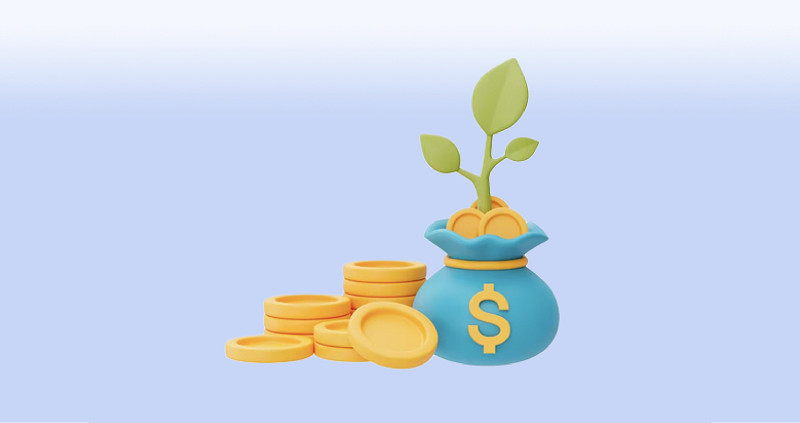Best ways to invest $50K
From building an emergency fund to growing long-term wealth, here are some of the best ways to invest $50,000.
Ways to invest 50,000 dollars: There are many options to consider if you have a large lump sum that you’d like to grow.
Financial check-up: Before investing, you might build an emergency fund and pay off high-interest debt to reduce financial risk.
Diversifying: Opting for a mix of stocks, bonds, and savings products can help reduce risk and improve the stability of your returns.
What to know before you invest $50K
If you’re in the enviable position of thinking, “I have $50K, what should I do?", this guide will help you understand your options. Investing $50,000 can be a powerful step towards building wealth, reaching financial goals, or securing your future. However, from low-risk savings products to higher-growth opportunities, there’s no one-size-fits-all approach, and the best investment for $50,000 will look different for everyone. Let’s look at what you could consider first.
Build an emergency fund
First things first, it’s a good idea to ensure you have a solid emergency fund available in an accessible savings account. Ideally, this would be equivalent to 3-6 months of living expenses, so you don’t have to dip into your investments in the case of an unexpected financial situation.
Pay off debt
If you have high-interest debt, such as credit cards or personal loans, consider paying this off first. Although this may not be the most exciting thing to do with your money, in terms of how to invest $50K wisely, eliminating high-interest loans gives you a guaranteed benefit — something the market can’t always do — and it may also feel worth it to gain financial peace of mind. Reading more about debt payoff plans can help you better strategize.
Know your financial goals
When deciding where to invest, knowing your financial goals and desired timelines will play a big part in forming your investment strategy. Are you saving for retirement, a house in five years, or a big vacation with the family? Later in this guide, you can read some example investment strategies for short-, medium-, and long-term goals.
Understand your risk tolerance
Before you invest, take time to understand how much risk you’re comfortable with. Would you prefer a modest but guaranteed return on your investment, or can you tolerate the ups and downs of the market for the potential of higher returns? Your investment timeline plays a key role here, too — if you’re hoping to grow your money over the next year or two, you’ll likely want to opt for lower-risk, short-term options.
Accounts to invest $50K in
Once you’ve considered the points above, it’s time to think about which accounts to use to hold your investments or savings. There isn’t one “best” place to invest, and where you put your money can impact taxes, returns, and flexibility, so it’s essential to do your research and compare rates, risks, and timelines.
Taxable brokerage accounts
A taxable brokerage account is one of the most flexible investment vehicles, allowing you to invest in a wide range of assets, including stocks, bonds, mutual funds, and ETFs, without contribution limits or withdrawal penalties. Many brokerage firms offer a range of accounts, from basic accounts that only allow you to buy and sell stocks, to more advanced platforms that provide access to trading and comprehensive financial planning tools. Taxable brokerage accounts allow for greater liquidity and fewer restrictions; however, you may be subject to capital gains tax if you sell investments for a profit.
Roth IRA
With a Roth IRA, you can invest post-tax income and withdraw earnings tax-free once you’ve retired. Contributions are limited to $7,000 per year as of 2025 (or $8,000 a year if you’re over 50), but you can open one or add to an existing Roth IRA based on income, if eligible. Once contributions are made, money in a Roth IRA can be invested in almost any mutual fund, stock, or bond of your choice.
Traditional IRA
A traditional IRA allows tax-deductible contributions and tax-deferred growth, but deductibility may be limited if a workplace retirement plan already covers you and your income exceeds certain thresholds.
Health Savings Account (HSA)
To contribute to an HSA, you must be enrolled in a high-deductible health plan (HDHP), but an HSA offers a triple tax advantage: contributions are tax-deductible, growth is tax-free, and withdrawals for qualified medical expenses are also tax-free. Plus, withdrawals for healthcare expenses can be made at any time, regardless of the profits your investments have earned.
529 plan
A 529 plan is a tax-advantaged account specifically for education savings. Contributions grow tax-free, and withdrawals are also tax-free, as long as the funds are used for qualified education expenses.
Best investment options for $50K
Once you’ve chosen the right account type to hold your funds — whether that’s a Roth IRA, HSA, or taxable brokerage account — the next step is deciding how to invest your $50,000. While the account type you choose will determine your tax advantages, the investment option(s) you choose will ultimately drive your returns. Here are some popular options you could consider:
Index funds
Index funds are mutual funds designed to passively track a market index, such as the S&P 500. They offer the ability to diversify your investment and usually come with relatively low fees, along with reliable long-term growth.
ETFs
ETFs (exchange-traded funds) are similar to index funds, but trade like individual stocks throughout the day. ETFs can track indexes, sectors, commodities, or bonds, and are often tax-efficient.
Individual stocks
Individual stocks give you ownership in a single company. While they offer high potential, they also generally carry more risk than diversified investments, such as ETFs or index funds.
Bonds
Bonds are a fixed-income investment, where you loan money to a government or corporation in exchange for interest payments. They are generally more stable than stocks and can provide a regular income.
Real Estate Investment Trusts (REITs)
REITs allow you to invest in real estate without buying property. These trusts own or finance income-producing real estate, with their profits going to you as an investor as dividends. Many REITs are publicly traded, offering liquidity, diversification, and potential long-term growth.
High-Yield Savings Accounts (HYSAs)
While high-yield savings accounts are not a traditional investment vehicle, they can be a great option to protect your principal while earning competitive interest, especially if you have cash that you want to keep liquid for an upcoming expense or are building savings for short-term goals. When comparing accounts, you might prioritize ones that offer deposit protection. Similarly, investing in certificates of deposit (CDs) gives you the benefit of fixed interest rates over a set period, making them a reliable, low-risk choice if you’re looking for predictable returns.
Should I invest $50K gradually or as a lump sum?
Investing gradually or as a single $50,000 lump sum — is really up to you and depends on your goals, timeline, and your attitude to risk.
Investing as a lump sum may give you the chance of better returns, as it maximizes your time in the market, which is key to long-term gains. It might also feel more straightforward, as you can invest once and then forget about it. However, with a lump sum, you’ll also be committing all your money at once, and there is a risk that you could invest just before a market drop. In general, you’ll find you need emotional resilience in riding out short-term market dips when all your money is invested in one account or account type.
Spreading out your investment reduces the risk of bad timing and may be easier mentally (especially if you’re new to investing or more risk-averse). However, it can also mean that you will have to leave part of your money in cash temporarily, thereby earning less (or even no interest) before you invest it.
DIY vs Robo vs financial advisor
When it comes to investing your $50K, how you manage your portfolio is just as important as what you invest in. There are three main approaches: do-it-yourself investing, using a robo-advisor, or working with a financial advisor. Below is a handy overview to compare the three options.
If managing your investments feels overwhelming or you want expert help in building a personalized financial plan, you may consider seeking independent financial advice.
Type | Description | Cost | Customization | Control | Ideal for |
DIY investing | You’re in full control, managing your portfolio and making all decisions yourself using a brokerage platform. | Typically the lowest cost option | High | Full control | Confident investors |
Robo-advisor | Automated platforms create and manage a diversified portfolio for you based on your goals and risk tolerance. | Low, but fees apply | Medium | Limited control | Beginners and passive investors |
Financial advisor | Personalized investment advice with a typically wide range of services, including retirement planning and estate planning. | High | High | Shared control | Complex or large portfolios, investment beginners |
Example investment plans by goal
Now that we’ve discussed options for investing $50K, let’s look at three investment plans tailored to common goals.
Short-term investing: Investors who are planning to use $50,000 within the next one to three years, for example, for a home down payment or a big vacation, might prioritize low-risk options and easy access to funds. You could consider high-yield savings accounts and certificates of deposit (CDs).
Medium-term investing: Investors with goals of three to seven years, such as funding education or starting a business, could aim for a mix of growth and capital preservation, with options such as balanced mutual funds or ETFs (a mix of stocks and bonds)
Long-term investing: If your goal is retirement or growing your wealth over more than ten years, you might be willing to take more risk for high potential returns in the long run. Options include broad market funds, ETFs, or alternative investments.
Save with Raisin
Whatever your investment goals are, one of the safest ways to invest $50K may be to keep part of your portfolio in high-yield savings products, especially if you want to build short-term or emergency savings. At Raisin, we make it easy to compare savings accounts and CDs with competitive rates, so your money can grow safely while staying accessible.
The above article is intended to provide generalized financial information designed to educate a broad segment of the public; it does not give personalized tax, investment, legal, or other business and professional advice. Before taking any action, you should always seek the assistance of a professional who knows your particular situation for advice on taxes, your investments, the law, or any other business and professional matters that affect you and/or your business.


